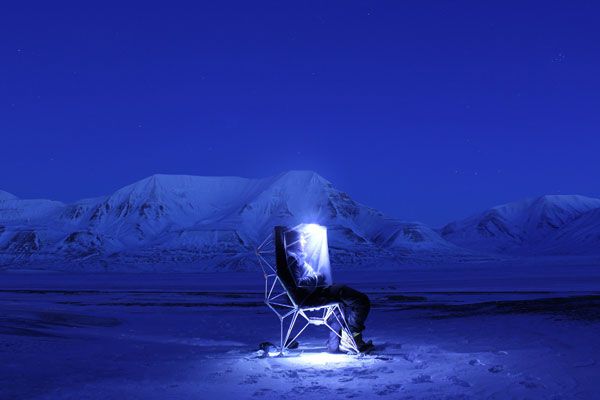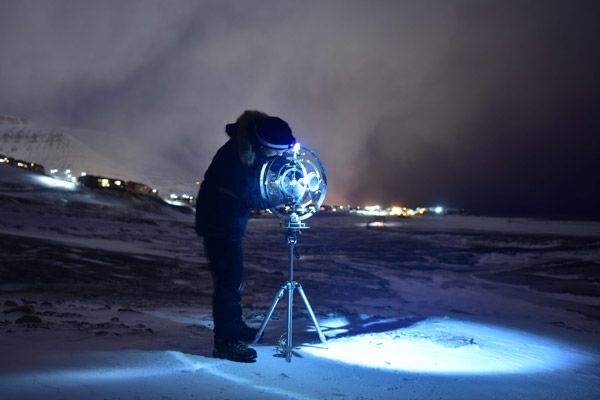Design and architecture in the Arctic is explored in a new exhibition now on at the Hong Kong Design Institute. Christie Lee writes.

December 30th, 2015
Top image: Differential Enclosure. Photo by David Garcia
Frigidly cold, expansive and replete with heavy white snow, the Arctic has always been a mystery for many.
Organised by the Hong Kong Design Institute, Hong Kong Institute of Vocational Education (Lee Wai Lee) and the Royal Danish Academy of Fine Arts, School of Architecture, The Arctic group exhibition in Hong Kong brings us a step closer to understanding this largely untamed region.
Comprising prototypes, videos, infographics and images, the exhibition came out of a three-week expedition to the Arctic in 2014, which was led by David Garcia, a professor at the Royal Danish Academy.
During the expedition, 28 students from the Architecture and Extreme Environments programme were each asked to conceive of a project that explored the design and architectural potential of a pristine yet wildly erratic environment.
“[The exhibition] describes a teaching methodology and creates awareness towards the practice of design and architecture, its strengths and flaws. It also presents a territory that is distant and extreme, but important to everyone,” explains Garcia.

Indeed, The Arctic goes beyond the realm of pure problem solving for one that balances function with aesthetics.
A highlight is Anita Eriksen’s “Steam and Light – Study of Water’s Architectural Potential”. Inspired by the beauty of geothermal power, the installation comprises seven stacked cubes. When both light and geothermal steam are introduced, the latter diffuses the former, giving more substantial form to the otherwise invisible steam.
A second exhibit explores ways of preserving human body warmth – by converting it into electricity that can be used for other purposes – and yet a third features an artificially-moulded ice shell that is used as temporary shelter against extreme conditions.
In exploring the potential and dangers of building in untamed locales, The Arctic also asks the question – should architects take up the responsibility of ensuring that the pristine, unspoiled environment of the wild be kept?
Garcia notes that “research can and should be as low impact as possible, but the minute we decide to inhabit and settle, the impact is unavoidable. Towns and cities have a large impact in their immediate environment and beyond. The question is, how can that impact be a considered one, where the resulting legacy of a settlement can be as balanced as possible?”
The Arctic runs through 22 February 22 2016 at C002 – Experience Center, Hong Kong Design Institute and Hong Kong Institute of Vocational Education (Lee Wai Lee).
INDESIGN is on instagram
Follow @indesignlive
A searchable and comprehensive guide for specifying leading products and their suppliers
Keep up to date with the latest and greatest from our industry BFF's!

Elevate any space with statement lighting to illuminate and inspire.

To honour Chef James Won’s appointment as Gaggenau’s first Malaysian Culinary Partner, we asked the gastronomic luminaire about parallels between Gaggenau’s ethos and his own practice, his multidimensional vision of Modern Malaysian – and how his early experiences of KFC’s accessible, bold flavours influenced his concept of fine dining.

In design, the concept of absence is particularly powerful – it’s the abundant potential of deliberate non-presence that amplifies the impact of what is. And it is this realm of sophisticated subtraction that Gaggenau’s Dishwasher 400 Series so generously – and quietly – occupies.

“In Australia, our diversity as a people is our design strength. We have a remarkable Indigenous heritage and also one of the youngest modern countries, post-colonisation,” says Plus Architecture’s Brendan Murray.
Blok Furniture is joining with QUT in a collaborative project at Brisbane Indesign.

Seeing one of its products copied by a national retailer, Made by Pen shares an opinion piece with Indesign on the replica industry and how one way of fighting back is through design integrity.
Finish: Metal frame with woven leather cord back.Different upholstery finishes as well as aged leather. Frame finishes in chrome, satin or burnished metal. Delivery time: 12 -16 weeks Applications: Commercial or residential Variations: Available as a single chair, sofas and chaise Designer: Antonio Citterio
The internet never sleeps! Here's the stuff you might have missed

It’s widely accepted that nature – the original, most accomplished design blueprint – cannot be improved upon. But the exclusive Crypton Leather range proves that it can undoubtedly be enhanced, augmented and extended, signalling a new era of limitless organic materiality.

Commercial specification just got more circular thanks to some new finish options for some of Klaro’s most loved pieces.